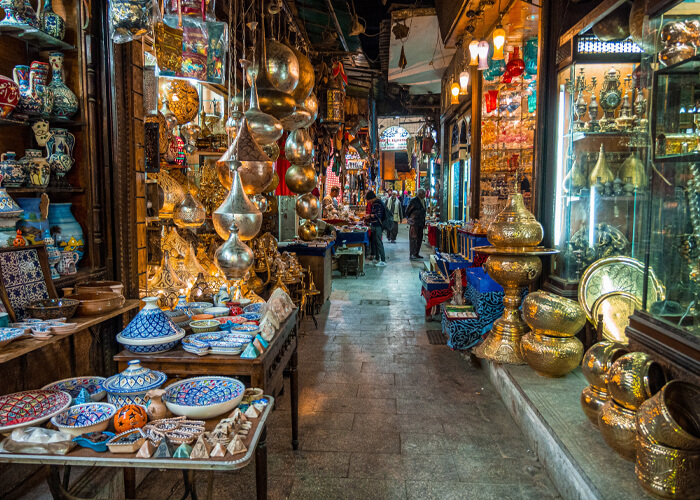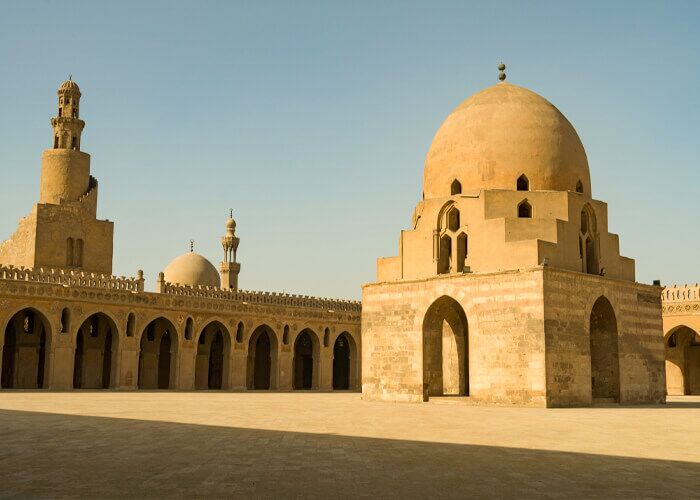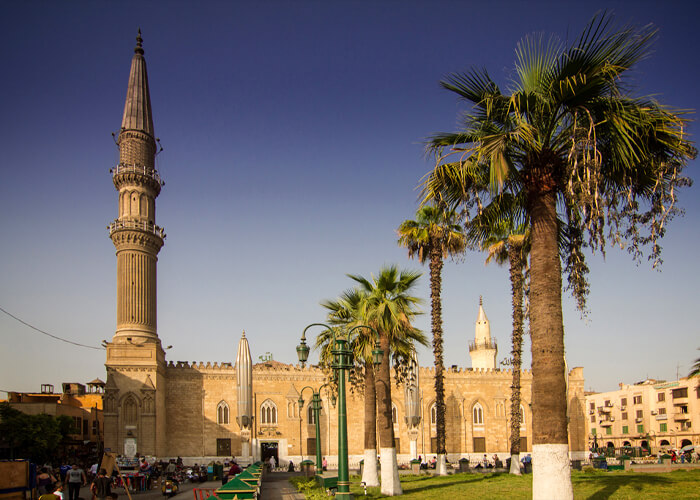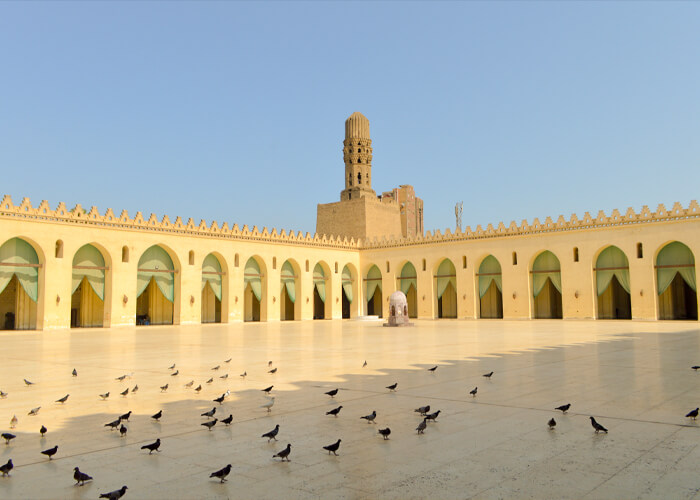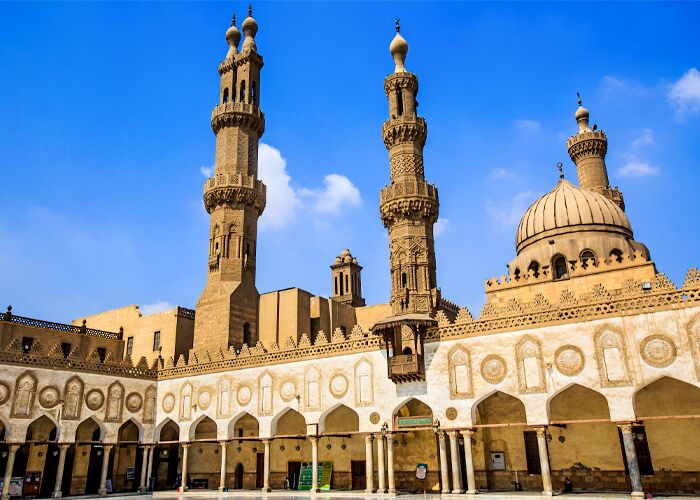An absolute must-see in Cairo is Khan El Khalili Bazaar.
What is Khan el Khalili’s location?
How long ago was it built?
What is the significance of Khan El Khalili, and how did it come about?
Getting through the Khan El Khalili Bazaar: Any pointers?
Any new country we visit, we’re always on the search for a unique corner shop or true market area.
Exotic spices and other hidden gems may be found at these markets, so they’re not only places to buy goods, but also places worth visiting for the sheer beauty and intrigue they provide.
Every Egypt vacation package or Nile cruise should include a visit at this famous market in Cairo, Egypt.
The Khan el Khalili Bazaar in Cairo is one of the world’s oldest and most attractive marketplaces.
For the most part, the origins of this unusual market, what it is, and the essential role it serves not just for the locals but also as one of Egypt’s top tourist attractions remain a mystery.
Khan El Khalil’s location and date of construction are unknown.
It’s no secret where the famous Khan el Khalili Bazaar may be found.
Since Egypt was the home of the ancient Egyptian Civilization and the strong pharaohs, Khan el Khalili has always been a source of intrigue.
This bazaar has served a wide range of purposes and fulfilled many diverse aims, which makes the stories that have been recounted about it throughout history all the more amazing.
Khan el Khalili’s history is entwined with Cairo’s history, and the structure has been rebuilt, repaired, and modified several times.
Fatimid era sources indicate that the Khan el Khalili Bazaar was constructed in the 10th century.
According to historical sources, Gawhar Al-Siqilli, a Fatimid commander who invaded Egypt and utilized his victory to create the ancient Bazaar in its present position, was the first to develop this region. To accommodate both his own family and other government institutions, Gawhar started construction of a vast palace complex in 969 CE.
Two palaces were completed, although only the larger Eastern and Western patterns were completed.
In the beginning, the broader east-west pattern was built first. Formerly the southern end of the eastern Fatimid palace, the current site of Khan el Khalili was used as a burial place for the Fatimid Caliphs.
When it was first designated as a city, however, the previously described Area was closed to the general public.
The mosque was restored to the public in the 14th century after the Fatimid Caliphate was defeated by Salah Ad-Din in 1171 and the mosque was closed to the public again.
To achieve a transformation from a place city to an economic powerhouse, Egypt’s rulers and state administration were relocated outside the walls of the city, paving the way for its transformation into a bustling economic centre visited by ordinary Egyptians and visitors.
Qasba (today known as Al-Muizz street) was the city’s primary axis during the Ayubids and the Mamluks, and was a favored and significant site for religious complexes and projects under both regimes..
This region’s accessible acreage started to shrink in favor of its streets, which were cultivated with many businesses, leaving little opportunity for future growth and development.
It was a combination of these circumstances, as well as officials’ desire for a more organized market and commercial sector, that led to the decision to replace mobile and street shops with stone structures that featured retail space.
In spite of the Black Death’s devastation of Cairo by the reign of Sultan Barquq, first Mamluk Sultan, it was still an economic and cultural powerhouse at the time.
Fatimid Complex was demolished and rebuilt with a vast Khan (market) in the heart of the city during the Sultan’s first reign, with numerous mamluk elites establishing commercial venues that would later be known as Khan El Khalili (Khan of the Khalili).
Several campaigns of demolition and rebuilding, as well as several name changes, occurred in Khan El Khalili throughout the sixteenth century..
It has evolved through time in order to mimic the Bedestan market in Ottoman cities, where the most precious and most expensive goods were exchanged in a central location.
Even after extensive renovation and reconstruction, many of the city’s historic structures have managed to retain their unique character and allure.
There were multiple Khans or wekalas of comparable items in Khan el Khalili bazaar’s final shape, with Souq streets used to traverse between them.
What is the significance of Khan El Khalili, and how did it come about?
After learning about the picturesque neighborhood’s rich past and present, it’s natural to wonder what it does for a job.
As time passed from the eleventh through the fifteenth century, the Great Khan transformed from an outlying fortress to a hub of trade in rare and valuable goods.
Now it’s a popular tourist spot where people from all over the world come together to mingle.
Market stalls are now mostly occupied by sellers who are either tourists or locals.
An genuine expertise may still be found in jewelry shops, for example.
Recreational institutions such as coffee shops, street food vendors, restaurants, merchants of unusual spices and herbs as well as others may be found throughout the neighborhood.
The Bazaar’s very unusual and different architectural styles and building processes, although peculiar to the East, are extremely captivating and mind-blowingly amazing.
There are various religious sites in the area, including the Al-Hussein Mosque and shrine and the Al-Azhar mosque, each of which tells a different tale.
Khan EL Khalili’s advice;
Listed below are some helpful tips for making the most of your time at the Khan El Khalili Bazaar.
There will be endless exhibits of handmade carpets, antiques, gold artifacts and antiquities, pharaonic souvenirs and other fascinating items to look out for here.
A walk along Muizz street, appreciating the Islamic architecture, or one of the many traditional coffee shops, which are popular with locals and visitors alike, are just a few of the many things to do in the Bazaar.
Since it’s in the heart of the city, using any of the several subway lines that pass through here is a cinch.
Hiring an uber might save you the hassle of transferring between buses or subway trolleys.
Take a minibus or microbus from EL Tahrir Square or Ramses Station.
To sum it up, using the Metro is an incredibly fast and handy choice.
In the end, a trip to Egypt wouldn’t be complete without seeing Khan el Khalil.
You’ll discover a wide variety of things to do in the city, from historic landmarks to bustling marketplaces to a spot to meet residents and tourists alike for tea and conversation.
El-Hussein is also a refuge for individuals in need, especially those who are depressed and desperate.
If you’re looking for an oasis of tranquility, complementation, beauty, wonderful company, and the best that Egypt has to offer in one place—then Khan El Khalili is the place for you.

